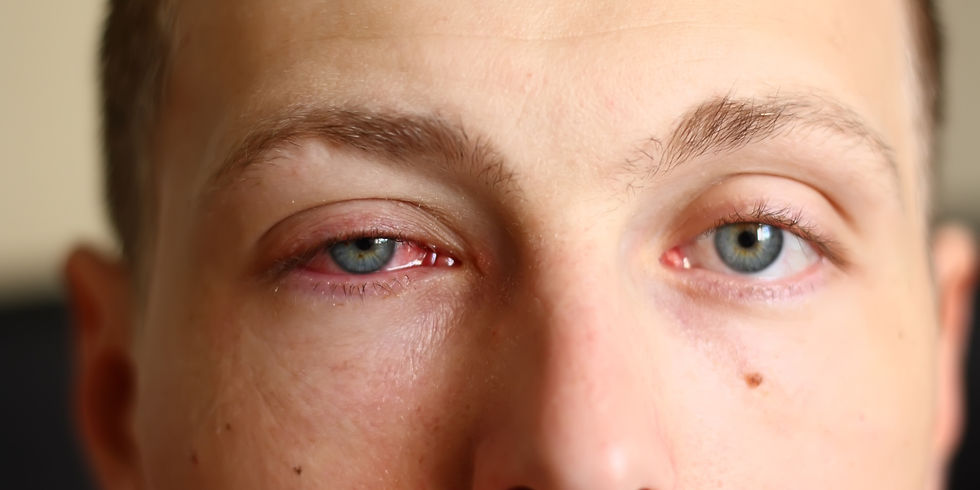Viral Conjunctivitis: The Other Pink Eye. Symptoms and Management
- Victoria Wermers, RN,MSN,FNP, PMHNP
- Sep 18, 2024
- 3 min read
Updated: Jul 12
It's sometimes difficult for some people to tell the difference between bacterial and viral conjunctivitis. They are both called "pink eye," but they are very different and each have distinct treatments. Read more here about viral conjunctivitis: The other pink eye. Symptoms and management.
Viral conjunctivitis is very contagious. It is caused by direct contact, by touching an infected surface, or by an upper respiratory condition like the common cold, flu, and, sometimes, COVID-19. It is primarily recognized by redness of the sclera (the white of the eye), redness of the inner lids, and sometimes swelling of the eyelids, tearing, itching, a gritty or burning feeling. The lymph nodes in front of the ears (preauricular lymph nodes) are sometimes swollen and tender. The drainage from the eye is usually clear. Viral conjunctivitis also tends to start in one eye and spread to the other. It is contagious for 5-7 days, so sometimes, while symptoms persist, people are asked not to return to work or school for that long.
Viral eye infections are usually treated with over-the-counter measures and home treatment. However, if the infection gets nasty, with profuse watering, puffiness, and redness, it would be wise to see a healthcare provider who can prescribe special eye drops to calm your inflammation. There is no known cure; it can last for one or two, sometimes three weeks. Treatment is primarily supportive.
The same home care applies to viral eye infections as it does to bacterial infections (see "Things to remember" above). Viruses are pretty contagious for the first few days, until drainage stops.
Many viruses can cause conjunctivitis; some of our close viral "friends" can, including adenovirus, COVID-19, measles, herpes simplex I, and herpes zoster. It is important to look at other respiratory symptoms as well.

Learn More About Viral Conjunctivitis: The Other Pink Eye. Symptoms and Management
Over-the-Counter Eye Drops for Viral Conjunctivitis
Most cases of viral conjunctivitis resolve naturally with support from symptomatic treatment. Over-the-counter eye drops—especially those targeting redness and inflammation—can ease discomfort as the infection runs its course. Many types are available, often found in artificial tears. Check labels for the following ingredients:
Naphthazoline/polyethylene glycol (i.e., Bausch and Lomb Eye Redness drops, Naphcon, Clear Eyes, and others)
Tetrahydrozoline (i.e., Murine, Visine)
Olopatadine (common: Pataday) (also prescription)
Ketofen ophthalmic (common: Zaditor, Alaway)
Natural Remedies for Viral Conjunctivitis
Many herbs claim to have antiviral and antimicrobial properties, but there is little research to support this. Therefore, herbal approaches are only suggested to soothe symptoms of the virus in hopes that it will come to pass. They may not eliminate the virus.
The remedies for bacterial conjunctivitis may help with viral as well:
Neem Leaves are used in Ayurvedic medicine (India) for conjunctivitis, so more studies are needed.
Chamomile (boiled and then cooled tea bags)
Tulsi (tea bags applied to lids; some people flush with a few drops of Tulsi tea but it is difficult to find much research on this)
Honey eye drops (ordered online) may work as an antimicrobial and anti-inflammatory, but little recent research has been done. Follow instructions.
Calendula - Solution applied to a gauze pad and dabbed on outer eyelids
If you are unable to recognize and manage your symptoms with the approaches in the abovementioned sections - Viral Conjunctivitis: The Other Pink Eye. Symptoms and Management - consider seeing a healthcare provider for diagnosis confirmation and appropriate treatment.
o
Prescriptive Treatment of Viral Conjunctivitis
Depending on the cause, most viral eye infections have to run their course using symptomatic relief (above). Suppose your eye infection is not improving, getting worse, and does not respond to symptomatic treatment. In that case, it may be wise to see your eye doctor, who has the equipment to rule out more severe problems.
Azelastine ophthalmic (Optivar)
Olopatadine ophthalmic (common: Pataday)
Providers can also prescribe ocular steroid drops or start you on an oral antiviral medication if necessary. While steroid drops may decrease inflammation and redness, they can also worsen some eye problems, so many primary care providers do not prescribe them. They leave it up to the ophthalmologists.
Note: If you have a rash near or around your eye, consider seeing an optometrist or ophthalmologist. You do not want that rash going into your eye.



